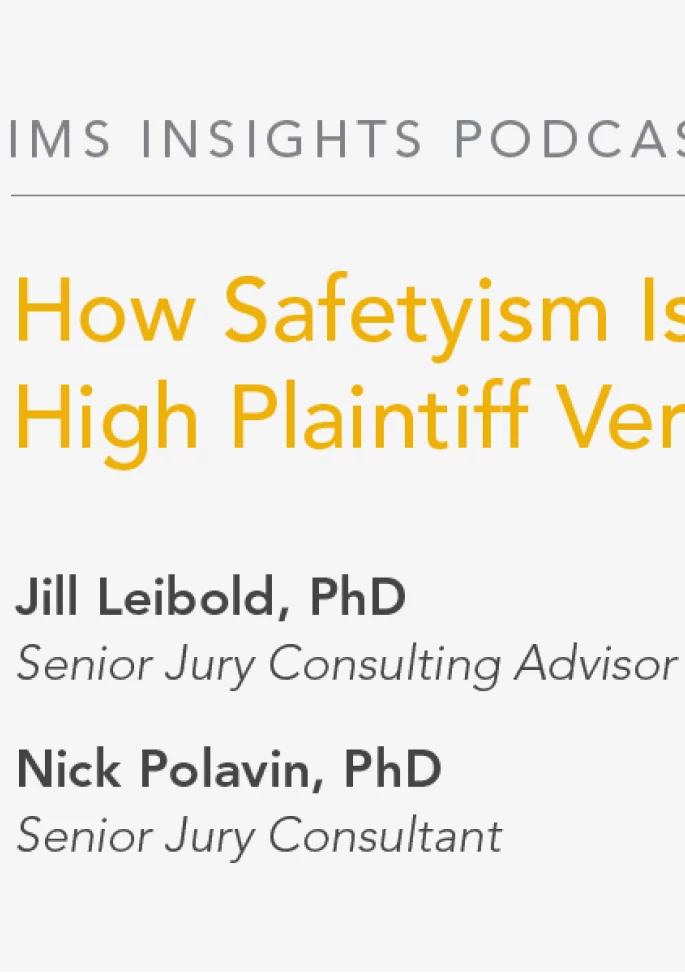“I don’t care about the data; if it happens once, it has happened one too many times." "If it’s going to be on the market, it needs to be 100% safe.” “If it has the ability to hurt someone, it’s defective.”
As these quotes from mock jurors reveal, jurors can hold unrealistically high expectations about product safety or corporate safety standards. Cars certainly come with risk, yet a vast number of Americans use them. Sharp knives are a feature of almost every kitchen, yet accidental cuts occur regularly. Any small object can be a choking hazard. So why is it that jurors can have such heightened safety expectations regarding products at trial?
With technological and medical advances, humans are safer now than they have ever been.[i],[ii],[iii],[iv],[v],[vi] Along with these innovations and increases in overall safety, people’s belief that they should be absolutely free from the risk of harm or discomfort has also risen. This phenomenon has been referred to as “safetyism.”
Safetyism is a societal trend that has been slowly emerging over the past two to three decades, but largely reared its head in litigation more recently. Think about the rise of nonstop, sensational media about disasters, safety mishaps, and criminal activity. It increased exponentially with the advent of the 24/7 news cycle, the progeny of seeds planted perhaps even as early 1979, as Americans latched onto uninterrupted coverage of the looming Three Mile Island disaster. Psychological literature has kept up with this trend, noting that the very concept of “risk” has changed, too. Where it used to be a calculation of the benefits in comparison to the potential harm,[vii] over time, risk changed to a feeling and how much of that feeling one was willing to tolerate.[viii] Today, risk is still a feeling, but one perceived increasingly as a threat, whereby any risk will lead to harm.
These long-term developments created a pervasive avoidance not just of physical harm, but also of emotional discomfort. And because humans are hard-wired to take “the path of least resistance,”[ix] we have developed means to minimize exposure to emotional distress—including cable news networks, internet, or social media accounts where we can tune into what we want to hear[x] and, maybe even more importantly, avoid what we do not want to hear.[xi] With more options for isolating ourselves from opposing viewpoints or facts (e.g., partisan news channels and social media), even the possibility of encountering such information can now be perceived as a threat to our belief system.[xii]
It is difficult to blame people for seeking to minimize discomfort, and there are many opinions about the effects of that pursuit on society. But what effect has the current state of safetyism had on litigation? How might a fixation on physical and emotional wellbeing shape jurors’ conception of “reasonable” when it comes to the actions and safety standards of corporations?
To shed some additional light on these issues, we recently conducted an online survey of jury-eligible respondents. The results identified key attitudes and demographics related to safetyism, discussed in more detail below.
The Tenets of Safetyism
In their 2018 book,[xiii] authors Greg Lukianoff and Jonathan Haidt describe three fallacious decision-making patterns that culminate in what they coined as “safetyism.” Those who are prone to these decision-making patterns we refer to as “safety-ists,” and have a tendency to behave in the following ways.
- Safety-ists focus on the worst possible scenario and perceive it as the most likely outcome, even when a realistic risk assessment may statistically make it highly unlikely. This mindset creates a full risk avoidance, leaving no room for reasonable or acceptable risks, not limited to products but also including verbal or written work, educational, and social encounters.
- Safety-ists put feelings first. They value gut or instinctual reactions above reasoned thought and evidence. Feelings guide their interpretation of information and even reality.
- Safety-ists see the world as a battle between good and evil, exacerbating the trend toward tribalism.
Safetyism Among Jurors
These faults in decision making translate to the litigation world as jurors with convictions that corporations should protect people, declining trust in corporations to do so, and increased expectations for stringent safety testing and standards. Jurors feel less in control of their own fates and futures, believing bad things that happen to them are caused by external forces—what social psychologists call an “external locus of control.” This view can lead jurors to overgeneralize a single instance (e.g., an individual plaintiff) into a more global threat. Thus, damages can become justice and a means of exerting personal control over corporations, leading to large awards for a single claim.
Furthermore, when jurors put feelings first—relying on their “gut reaction” rather than reasoned thought and diligent research—they tend to interpret the evidence through a lens of fear and distrust of corporations. This has led to an increase in emotional reasoning that impacts how jurors hear the testimony of corporate representatives and scientific experts; namely, they discount it in favor of their gut reaction.
The increase in tribalism has impacted verdicts as well. Tribalism more often positions corporations as the adversary in a good-versus-evil worldview, all while emboldening jurors to stick to their emotions and resist arguments from jurors with contrasting views. This can mean less compromise alongside more combative interactions, fueled by these polarized, emotionalized views.
Initial Survey Results
We recently completed an online survey with 200 jury-eligible respondents to assess issues related to safetyism and gather some background information and attitudes on litigation. We measured safetyism using eight questions that assessed respondents’ opinions and actions regarding two components of safety:
- Concern for harm (e.g., “If I read that a product might cause cancer, I would stop using that product”)
- Beliefs about the degree of safety precautions corporations should take (e.g., “Products and pharmaceuticals should warn about every possible risk or side effect, no matter how small”)
We identified the following key demographic indicators of high safetyism jurors:
- Higher education
- Urban residents
- Main news source was social media, podcasts, and the internet (traditional news sources such as TV and radio were indicators of lower safetyism)
- Registered Democrats (with a tendency to be further left on the political spectrum)
- Strong belief in scientific conclusions from noncorporate sources
- More likely to have been COVID vaccinated
- More likely to plan to receive a COVID booster shot
Safety-ist jurors' tendency to strongly believe in scientific conclusions from noncorporate sources could, on the other side of the coin, be interpreted as jurors having a gut reaction to, and emotional distrust of, corporate-funded studies, which may undercut their belief in some scientific studies.
Buy-in to safety entitlements is critical to product liability, mass tort, the trucking industry, and personal injury matters, in that jurors’ safetyism glasses can color the evidence in these cases. Notably, for almost every safetyism question in the survey, the vast majority of respondents indicated heightened safety concerns and exceedingly high expectations of manufacturers. For instance, 92% of respondents agreed with the statement, “Companies should take every possible measure to ensure their products are 100% safe.” Regarding warnings, 83% agreed that products and pharmaceuticals should warn about every possible risk or side effect, no matter how small. Moreover, the results showed that 69% of respondents indicated they would stop using a product if they read it might cause cancer. In fact, 66% said that they had already stopped using a product due to health and safety concerns.
Reducing the Role of Safetyism in Juror Decision Making
Given these findings, as well as the broader rise of safetyism in society, how can attorneys guard against safety-ist attitudes in juror decision making? Attorneys should present a theme early on (and repeat it often) emphasizing that jurors should decide using, e.g., “Facts, Not Feelings.” Acknowledge that it is absolutely normal to have feelings, but trials are about the law, the facts, and the evidence, so while everyone will have feelings about the parties or witnesses, those are not facts. Further, as early as voir dire, explain to jurors that the legal system is a tier of accountability—the judge will be held accountable for their decisions to an appeals court, just as the court and judge in this case will hold the jury accountable for its decisions—so they are not to be made lightly. And that includes taking the facts one at a time, rather than trying to use opinions or bend facts to fit a desired outcome for either side.
Psychological research tells us that when people know they will be held accountable and are encouraged to set high standards for the group (in this case using evidence and law instead of feelings), their performance improves.[xiv] Indeed, one legal expert, after analyzing jury deliberation data, stated that one of the more important factors in a jury deliberation was “the seriousness with which the jurors approached their job and the extent to which they were concerned that the verdict they reached was consistent with the spirit of the law and with the facts of the case.”[xv]
Additionally, to combat tribalism, attorneys should offer jurors phrases and themes that will act as olive branches to dissenting jurors in deliberations. More neutral language such as “Follow the Science” and “Probabilities, Not Possibilities” support the “Facts, Not Feelings” directive, but are phrased such that they can be repeated during conflicts in deliberations to help focus safety-ist jurors back toward the law and the evidence in a non-threatening way.
Lastly, preparing witnesses to better relay their findings and opinions may help to break down barriers to jurors’ openness. A combative expert or a representative who does not have the appropriate company knowledge can lead to juror distrust. The more an expert or corporate representative can appear relatable and can explain the science and company policies/decisions in familiar, everyday terms, the more credible and trustworthy they will be. As post-trial interviews reveal, once jurors trust the messenger, they trust the message (e.g., the science).
Conclusion
Many defendants have experienced this new “risk aversion” reality firsthand as the number and size of nuclear verdicts have continued to rise. As one recent report indicates, current verdict trends are returning some sobering statistics: Upon review of 1,376 nuclear verdicts from 2010-2019, researchers found that 16% of verdicts were over $50 million, and within that group, 101 damage awards were over $100 million.[xvi] Many of the most shocking verdicts hitting the news cycle have notable links to safetyism. Some may recall, for instance, a 2022 verdict in Dallas levying a $7 billion punitive damage award against a cable company whose technician murdered an 83-year-old in her home. Jurors pointed to the company’s “negligent hiring practices.”[xvii]
Today’s jurors, with their heightened safety concerns, are being tasked with judging companies’ actions from 10, 20, or even 50 years ago; we can see why most do not live up to their modern concept of “reasonable.” But the reality of safetyism is that any past or present corporate action viewed as “cutting corners” regarding safety stands to raise the temperature of jurors’ anger—and increase defendants’ chances of facing a nuclear verdict.
This article was originally published by Law360. Republished with permission.
References
[i] Brown, J. (2020, July). Nearly 50 Years of Occupational Safety and Health Data. U.S. Bureau of Labor Statistics. https://www.bls.gov/opub/btn/volume-9/nearly-50-years-of-occupational-safety-and-health-data.htm
[ii] Ingraham, C. (2015, April 14). There’s Never Been a Safer Time to Be a Kid in America. Washington Post. https://www.washingtonpost.com/news/wonk/wp/2015/04/14/theres-never-been-a-safer-time-to-be-a-kid-in-america/
[iii] Dietrich, E. (2016, July 24). Is the World More Dangerous Now than Ever? Psychology Today. https://www.psychologytoday.com/us/blog/excellent-beauty/201607/is-the-world-more-dangerous-now-ever
[iv] Raphael, T. J. (2014, October 23). The World Is Actually Safer Than Ever. And Here’s the Data to Prove That. The World. https://theworld.org/stories/2014-10-23/world-actually-safer-ever-and-heres-data-prove
[v] National Highway Traffic Safety Administration (n.d.). Newer Cars Are Safer Cars. https://www.nhtsa.gov/newer-cars-are-safer-cars#:~:text=Vehicle%20safety%20has%20changed%20drastically,safety%20features%20to%20protect%20you
[vi] Finlay, M. (2022, October 1). How Has Aviation Safety Improved Over the Years? Simple Flying. https://simpleflying.com/how-has-aviation-safety-improved-over-the-years/#:~:text=Because%20of%20the%20safety%20measures,flights%20in%20the%20United%20States
[vii] Slovic, P. (1987). Perception of Risk. Science, 236(4799). 280-285.
[viii] Loewenstein, G. F., Weber, E. U., Hsee, C. K. & Welch, N. (2001). Risk as Feelings. Psychological Bulletin, 127(2). 267-286.
[ix] Beaton, C. (2017, March 11). We’re Wired to Take the Path of Least Resistance. Psychology Today. https://www.psychologytoday.com/us/blog/the-gen-y-guide/201703/were-wired-take-the-path-least-resistance
[x] Knobloch-Westerwick, S. & Meng, J. (2009). Looking the Other Way: Selective Exposure to Attitude-Consistent and Counterattitudinal Political Information. Communication Research, 36(3), 426-448.
[xi] Garrett, R. K. (2009). Politically Motivated Reinforcement Seeking: Reframing the Selective Exposure Debate. Journal of Communication, 59(4), 676-699.
[xii] Hart, W., Albarracín, D., Eagly, A. H., Brechan, I., Lindberg, M. J., & Merrill, L. (2009). Feeling Validated Versus Being Correct: A Meta-Analysis of Selective Exposure to Information. Psychological bulletin, 135(4), 555-588.
[xiii] The Coddling of the American Mind: How Good Intentions and Bad Ideas Are Setting Up a Generation for Failure. Penguin Books, 2018.
[xiv] Zander, A. (1996). Motives and goals in groups. New Brunswick, NJ: Transaction Publishers.
[xv] Simon, R.J. (1980). The jury: Its role in American society. Lexington, MA: Heath.
[xvi] Silverman, C. & Appel, C. (2022). Nuclear Verdicts: Trends, Causes, and Solutions. U.S. Chamber of Commerce Institute for Legal Reform.
[xvii] William Goff et al. v. Roy James Holden, Jr. and Charter Communications








